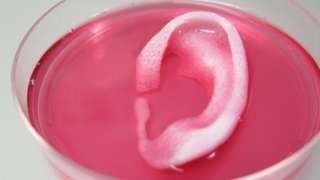If the organs and tissues grown in labs are to be successfully transplanted into bodies, then growing the blood vessels needed to maintain them becomes very important. A May 24, 2016 news item on ScienceDaily describes a new technique for the growing the vessels,
Growing tissues and organs in the lab for transplantation into patients could become easier after scientists discovered an effective way to produce three-dimensional networks of blood vessels, vital for tissue survival yet a current stumbling block in regenerative medicine.
In addition the technique to grow the blood vessels in a 3D scaffold cuts down on the risk of transplant rejection because it uses cells from the patient. It was developed by researchers from the University of Bath’s Department of Pharmacy and Pharmacology, working with colleagues at Bristol Heart Institute.
A May 24 (?), 2016 University of Bath (UK) press release, which originated the news item, expands on the theme (Note: Links have been removed),
So far the shortage of adequate patient-derived scaffolds that can support blood vessel growth has been a major limitation for regenerative medicine and tissue engineering.
Other methods only allow limited formation of small blood vessels such as capillaries, which makes tissue less likely to successfully transplant into a patient. In addition other methods of tissue growth require the use of animal products, unnecessary in this technique which uses human platelet lysate gel (hPLG) and endothelial progenitor cells (EPCs) – a type of cell which helps maintain blood vessel walls.
Dr Giordano Pula, Lecturer in Pharmacology at the University of Bath and head of the research team making the discovery, said: “A major challenge in tissue engineering and regenerative medicine is providing the new tissue with a network of blood vessels, and linking this to the patient’s existing blood supply; this is vital for the tissue’s survival and integration with adjacent tissues.
Dr Paul De Bank, Senior Lecturer in Pharmaceutics at the University of Bath and co-author of the paper, said: “By embedding EPCs in a gel derived from platelets, both of which can be isolated from the patient’s blood, we have demonstrated the formation of a network of small vessels. What is more, the gel contains a number of different growth factors which can induce existing blood vessels to infiltrate the gel and form connections with the new structures. Combining tissue-specific cells with this EPC-containing gel offers the potential for the formation of fully vascularised, functional tissues or organs, which integrate seamlessly with the patient.
“This discovery has the potential to accelerate the development of regenerative medicine applications.”
Professor Peter Weissberg, Medical Director of the British Heart Foundation, said: “Over a half a million people in the UK are living with heart failure, a disabling condition which can leave people unable to carry out everyday activities such as climbing the stairs or even walking to the shops. This regenerative research brings the British Heart Foundation’s goal to mend a broken heart and beat heart failure one step closer.
“All living tissues, including new heart muscle, need a blood supply. One of the fundamental goals of regenerative medicine is to find ways to grow a new blood supply from scratch. Previous attempts at this using human cells and synthetic scaffolds have met with only limited success.
“The beauty of this new approach is that components of a person’s own blood could be manipulated to create a scaffold on which new blood vessels could grow. This increases the likelihood that the new tissue will be integrated into the patient’s body which, if proven successful with more research, could improve the lives of people affected by heart failure.”
Here’s a link to and a citation for the paper,
Platelet lysate gel and endothelial progenitors stimulate microvascular network formation in vitro: tissue engineering implications by Tiago M. Fortunato, Cristina Beltrami, Costanza Emanueli, Paul A. De Bank & Giordano Pula. Scientific Reports 6, Article number: 25326 (2016) doi:10.1038/srep25326 Published online: 04 May 2016
This is an open access paper.
One of the criticisms of Paolo Macchiarini’s work with synthetic tracheas centered around blood supply to the cells (from my April 19, 2016 posting; it was part 1 of a 2-part series),
This ground-breaking achievement consisted of bringing to life a dead windpipe from a donor, by putting it in a plastic box, a so-called ‘bioreactor’ together with bone marrow fluid (stem cells). A few weeks later, I [Pierre Delaere*] wrote a letter to The Lancet, pointing out:
“The main drawback of the proposed reconstruction is the lack of an intrinsic blood supply to the trachea. We know that a good blood supply is the first requirement in all other tissue and organ transplantations. Therefore, the reported success of this technique is questionable” (correspondence by Delaere and Hermans, Lancet 2009).
The excerpt you’ve just seen features part of an open letter Pierre Delaere (a long time Macchiarini critic), published in Leonid Schneider’s blog ‘For Better Science’ in an April 2, 2016 posting.
Getting back to Bath, this is exciting stuff and I hope the research is reproducible.

![Figure 2: Brush-spinning of nanofibers. (Reprinted with permission by Wiley-VCH Verlag)) [downloaded from http://www.nanowerk.com/spotlight/spotid=41398.php]](http://www.frogheart.ca/wp-content/uploads/2015/09/Haribrush_nanofibres.jpg)